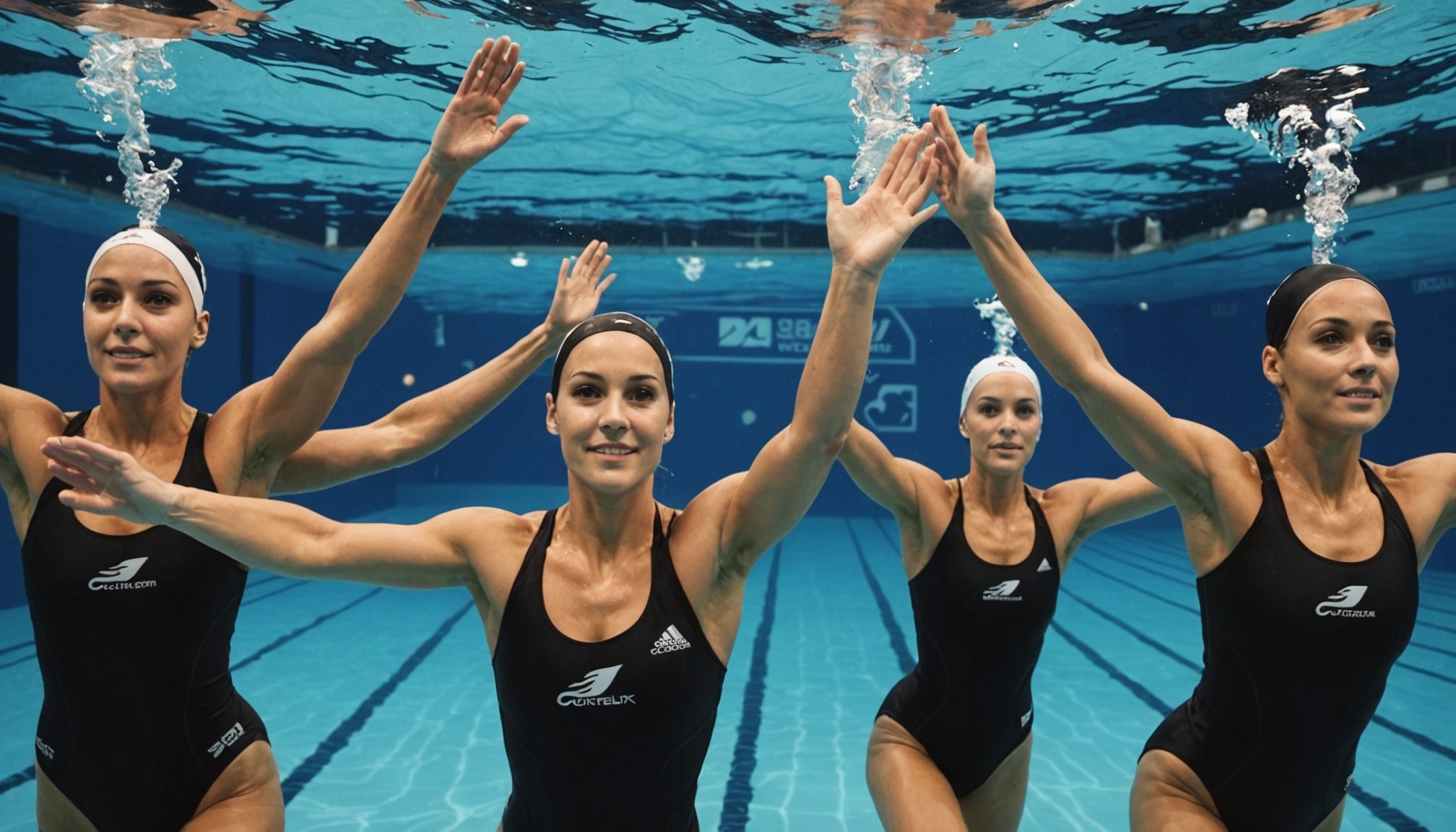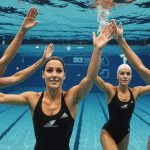Enhancing Underwater Breath Control
Breath control is a vital component of synchronized swimming, where precision in timing and rhythm is key. The synergy between rhythm and breath control allows athletes to execute complex underwater techniques seamlessly. By mastering the synchronization of movements and breathing, swimmers can enhance their performance significantly.
Maximizing lung capacity is crucial for effective breath control. One technique to achieve this is diaphragmatic breathing, which involves deep breaths filling the lungs entirely. This practice not only augments lung capacity but also promotes efficient oxygen use. Incorporating this technique into regular training regimes aids in sustaining breath for longer durations during underwater sequences.
Also to discover : Mastering Stroke Technique: A Competitive Swimmer”s Guide to Optimizing Performance Across Events
For those seeking to improve, specific drills can be implemented to strengthen breath control abilities. One method is the “paced breathing drill,” where swimmers control their inhale and exhale in tandem with their strokes or movements. Another exercise is static apnea, which involves holding one’s breath while remaining still underwater for progressive intervals, fostering better breath management.
Regular practice of these drills enhances a swimmer’s ability to remain submerged with confidence, supporting the execution of intricate routines. By integrating these structured techniques, synchronized swimmers can achieve superior breath control, thereby elevating their overall skill set.
Also to see : Maximizing Rowing Performance: The Power of Heart Rate Monitoring for Enhanced Training
Physical Conditioning for Synchronized Swimming
Synchronised swimming demands athletes maintain a high level of physical conditioning to excel in competitions. It’s essential to focus on key muscle groups that enhance aquatic performance. Targeting core muscles, shoulders, and legs is crucial, as these areas support the intricate movements and lifts expected in routines.
To build overall strength and endurance, consider incorporating exercises like squats and lunges for leg strength, and planks to enhance core stability. Swimming laps and incorporating resistance training using water weights can significantly boost both muscle strength and cardiovascular endurance.
Stamina maintenance is equally important, as routines typically involve intense activity over extended periods. Regular aerobic exercises such as running or cycling can complement swimming workouts, improving overall endurance levels.
Flexibility and core strength are integral to synchronised swimming, ensuring athletes can achieve the required range of motion and fluidity in water. Stretching routines, particularly focusing on the hamstrings and shoulders, alongside yoga or Pilates, can greatly improve flexibility. Additionally, core exercises like Russian twists and leg raises can fortify the body against the physical demands of demanding routines.
In summary, a strategic approach to physical conditioning—focusing on targeted strength training, stamina, and flexibility—can enhance synchronised swimming performance and support peak athleticism.
Effective Training Drills
In striving for performance improvement, implementing the right training drills is vital. Let’s explore various drills designed to enhance underwater skills.
Drill for Endurance Building
Training drills that focus on endurance building help athletes maintain energy over extended periods. Incorporating exercises such as swimming laps with timed intervals increases aerobic capacity. Using these techniques in regular practice ensures that the body adapts to prolonged exertion, a key advantage in competitions.
Technique Drill for Synchronization
Synchronization drills improve coordination and team dynamics. Exercises like synchronized swimming routines enhance underwater skills and encourage fluid movements. By practicing these drills, athletes can achieve a unified motion that is both efficient and aesthetically pleasing.
Challenge Drills for Increased Stamina
Challenge drills are essential for boosting stamina. By simulating competition conditions, athletes can push their limits. Implement specific drills like repeated sprints with short recovery periods; these exercises mimic real events and prepare athletes for the unpredictability of actual competitions. Integrating such conditioning drills into practice regimens ensures consistent stamina growth, pivotal for performance improvement.
Developing underwater skills through these carefully structured drills can lead to remarkable progress, propelling athletes toward excellence.
Nutritional Strategies for Optimal Performance
Maintaining ideal energy levels is crucial for synchronized swimmers. Their nutrition directly influences stamina and overall performance. Before training, it’s essential to consume a meal rich in carbohydrates and proteins. Carbohydrates provide the necessary fuel, while proteins aid in muscle repair and maintenance. Suitable pre-training options include whole grains, lean meats, and fruits. Ensuring the intake of a balanced meal helps sustain energy through intense routines.
Post-training, the focus shifts to recovery. Consuming adequate proteins and carbohydrates shortly after practice aids in muscle recovery and replenishment of glycogen stores. Nutritious options like smoothies with Greek yogurt and bananas or chicken with quinoa serve these purposes effectively.
Hydration is of utmost importance in synchronized swimming. The physical demands require consistent intake of fluids before, during, and after training. Water is essential, yet the inclusion of drinks containing electrolytes can significantly benefit athletes. Electrolytes help maintain fluid balance, essential for preventing cramps and sustaining performance levels.
By adhering to these nutritional strategies, synchronized swimmers can optimize their energy levels, support recovery, and enhance performance. These recommendations lay the groundwork for ensuring that athletes not only meet the physical demands but also excel in their routines.
Mental Strategies for Enhanced Performance
In competitive environments, focus and motivation are paramount. Techniques to maintain focus during practice and competition can make a significant difference. Athletes often use mental strategies like deep breathing to centre their attention. This simple act not only calms the nerves but also sharpens concentration.
Another powerful tool is visualization. By mentally rehearsing their performance, athletes can improve their underwater techniques. Imagining successful execution under pressure helps in creating neural patterns akin to physical practice. This approach is not just helpful for enhancing specific skills but also for boosting self-confidence.
Equally important is building a positive mindset. Adopting an optimistic outlook and learning to cope with pressure can significantly impact an athlete’s performance. To foster resilience, some athletes practice positive self-talk. Reminding themselves of past successes doesn’t just uplift their mood, it reinforces their ability to handle demanding situations.
Lastly, setting small, achievable goals can help maintain motivation and concentration. Breaking down larger goals into manageable tasks shows progress and keeps discouragement at bay. These mental strategies enable athletes to stay focused and motivated while navigating the ups and downs of their sporting journey.
Step-by-Step Workout Plans
Creating a workout plan requires careful structuring to ensure a balanced approach. For synchronized swimmers, a typical weekly training schedule may consist of a mix of conditioning, technique work, and rest, each element contributing to a comprehensive routine structure.
Conditioning sessions might include cardio, strength training, and flexibility exercises to improve overall fitness. Conditioning helps swimmers build endurance and strength, allowing them to execute routines with precision and poise. For instance, dedicating 3-4 days a week to these aspects provides a solid foundation.
Technique work is crucial for refining movements and enhancing performance quality. This includes practising routines, honing specific skills, and working on synchronisation with teammates. Typically, swimmers might focus on technique 2-3 days weekly, often in conjunction with conditioning.
Rest is just as vital; it allows the body to recover, preventing injuries and burnout. Therefore, including at least one rest day per week is advisable to maintain a healthy balance.
Adapting this schedule to meet individual performance goals is key. Athletes should assess their strengths and weaknesses, adjusting their plans in response. This flexibility ensures that the workout plan remains effective and aligned with personal objectives, maximising growth and development.











